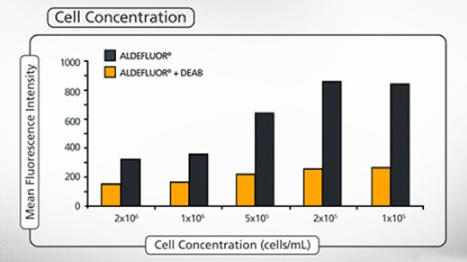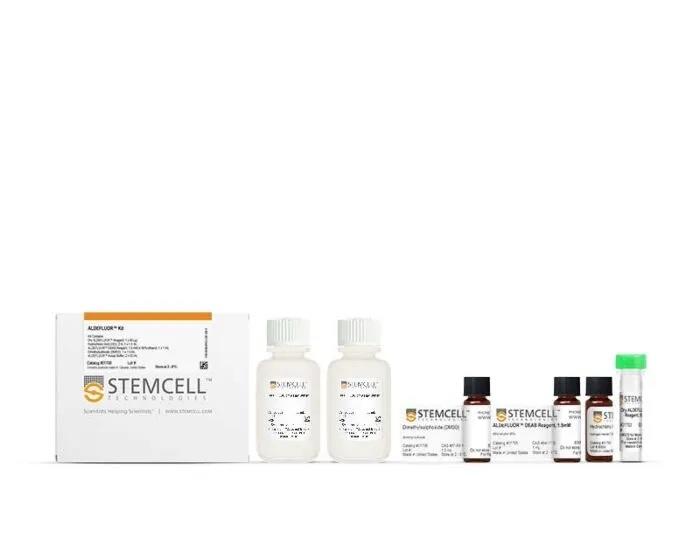注目の製品情報
2019/12/19
「ALDEFLUOR」 正常およびがん幹細胞/前駆細胞の同定、評価、分離
- 細胞分離
- 用途別細胞培養
ALDEFLUOR™は、アルデヒドデヒドロゲナーゼ高発現(ALDHbr)細胞を検出するための非免疫蛍光試薬システムです。80以上の異なる組織を対象として、1000報以上の論文で報告された実績があります。
ALDHの高発現は、造血・乳腺・内皮・間葉・神経を含むさまざまな系統の、正常およびがん幹細胞/前駆細胞で報告されています。
ALDEFLUORの反応生成物は、無傷の細胞膜を持つ細胞だけが保持できることから、生存中のALDHbr細胞が選択的に標識されます。
ALDEFLUORは、無毒性で使いやすく、抗体染色が不要のキットであり、標準的なセルソーターおよびセルアナライザーに適合しています。
ALDEFLUOR™が使用される理由
- 抗体不使用 ALDH活性に基づいて正常またはがん前駆細胞を検出し、抗体染色は不要
- 汎用性 複数の細胞タイプおよび動物種で使用可能
- 有益さ 無傷の細胞膜を持つ生細胞のみを識別し、抗体をもちいたImmunophenotyping(免疫表現型検査)との併用が可能
- 実績 1000以上の査読済み論文をサポート
- 使いやすさ 再現性の高い結果が得られるシンプルなプロトコルと、標準的フローサイトメーターへの適合性
ALDEFLUOR™の原理と使い方
正常およびがん前駆細胞を検出する仕組み
ALDEFLUOR™ kitには、無傷の生細胞内に自由に拡散する無毒性のALDH蛍光基質、BODIPY-アミノアセトアルデヒド(BAAA)が含まれています。ALDH存在下で、BAAAはBODIPY-アミノアセテート(BAA)に変換されます。BAAは負に帯電しており細胞内に保持されます。BAAの細胞内蓄積によって蛍光強度が高まり、ALDH-bright(ALDHbr)細胞としてフローサイトメトリーで分析できます。
ALDEFLUORアッセイ手順とALDHbr細胞の検出
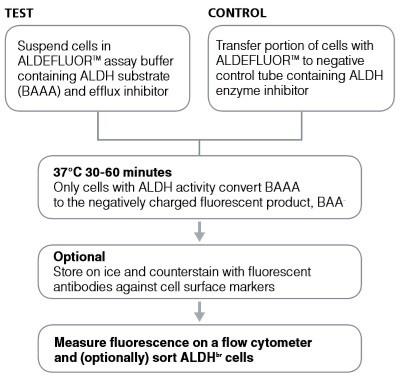
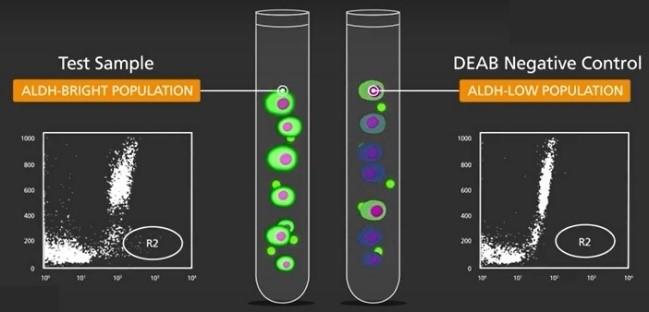
細胞をALDEFLUOR assay bufferに懸濁し(TEST)、うち半量をALDH阻害剤のDEABを加えたチューブに移してネガティブコントロール(CONTROL)とします。37℃で30~60分間インキュベートしてから、フローサイトメーターで蛍光を測定します。
詳しいマニュアルは、製品ページへ>>
ALDEFLUORの仕組み
さまざまな組織に合わせたアッセイの最適化
ALDEFLUOR™は当初、ヒト血液および骨髄中のALDHbr造血幹細胞/前駆細胞の検出用に開発および最適化されました。その後、他の多くの組織タイプ(乳房、結腸、肺、膵臓、甲状腺を含む)の正常細胞および腫瘍細胞、ならびにがん細胞株を検出することも示されています。
目的の組織タイプに合わせてALDEFLUORプロトコルを最適化すると、蛍光強度が劇的に増加し、アッセイのパフォーマンスが最適化されます。最適化を検討すべき条件として、細胞濃度、排出阻害、インキュベーション時間、ネガティブコントロールがあります。
以下の動画で、乳腺組織のALDHbr細胞の蛍光強度をどのように増加させたか、そして研究ニーズに合わせてプロトコルを変更する方法の例をご覧ください。
その他の技術資料
ALDEFLUOR™ Kit の仕様
ALDEFLUOR™ Kit(ST-01700)の構成
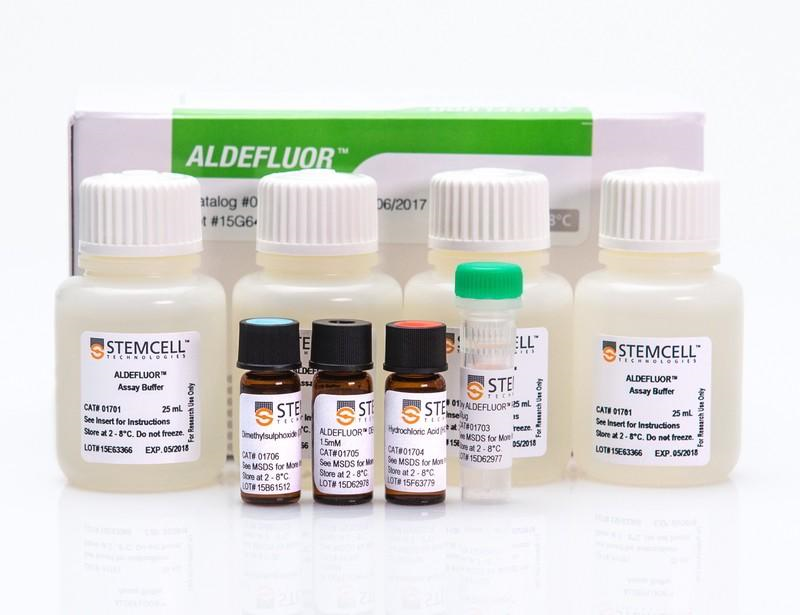
- Dry ALDEFLUOR reagent、50 µg
- Diethylaminobenzaldehyde (DEAB), 1.5 mM in 95% ethanol、1 mL *
- 2N HCl、1.5 mL
- Dimethylsulphoxide (DMSO)、1.5 mL
- ALDEFLUOR Assay Buffer、25 mL x 4本 **
- ALDEFLUOR Quick Reference Guide
* 単品販売あり(ST-01705)
** 単品販売あり(ST-01701, ST-01702)
1キット当たり40テスト分です(活性化したALDEFLUOR試薬を100 µLずつ分注した場合)。活性化したALDEFLUOR試薬は、-20℃以下で1年間安定に保存できます。
使用方法はマニュアル(添付文書)をご覧ください。
ALDEFLUORの主要文献(正常細胞)
造血
Boxall SA et al. (2008) Haematopoietic repopulating activity in human cord blood CD133+ quiescent cells. Bone Marrow Transplant 43(8): 627-35.
Capoccia BJ et al. (2009) Revascularization of ischemic limbs after transplantation of human bone marrow cells with high aldehyde dehydrogenase activity. Blood 113(21): 5340-51.
Christ O et al. (2007) Improved purification of hematopoietic stem cells based on their elevated aldehyde dehydrogenase activity. Haematologica 92(9): 1165-72.
Fallon P et al. (2003) Mobilized peripheral blood SSCloALDHbr cells have the phenotypic and functional properties of primitive haematopoietic cells and their number correlates with engraftment following autologous transplantation. Br J Haematol 122: 99-108.
Gentry T et al. (2007) Isolation of early hematopoietic cells, including megakaryocyte progenitors, in the ALDH-bright cell population of cryopreserved, banked UC blood. Cytotherapy 9(6): 569-76.
Gentry T et al. (2007) Simultaneous isolation of human BM hematopoietic, endothelial and mesenchymal progenitor cells by flow sorting based on aldehyde dehydrogenase activity: implications for cell therapy. Cytotherapy 9(3): 259-74.
Gündüz E et al. (2010) Evaluation of mobilized peripheral stem cells according to CD34 and aldehyde dehydrogenase expression and effect of SSC(lo) ALDH(br) cells on hematopoietic recovery. Cytotherapy 12(8): 1006-12.
Hess DA et al. (2004) Functional characterization of highly purified human hematopoietic repopulating cells isolated according to aldehyde dehydrogenase activity. Blood 104(6): 1648-55.
Hess DA et al. (2008) Widespread nonhematopoietic tissue distribution by transplanted human progenitor cells with high aldehyde dehydrogenase activity. Stem Cells 26(3): 611-20.
Liu C et al. (2010) Progenitor cell dose determines the pace and completeness of engraftment in a xenograft model for cord blood transplantation. Blood 116(25): 5518-27.
Muramoto GG et al. (2010) Inhibition of aldehyde dehydrogenase expands hematopoietic stem cells with radioprotective capacity. Stem Cells 28(3): 523-34.
Pearce DJ & Connet D. (2007) The combined use of Hoechst efflux ability and aldehyde dehydrogenase activity to identify murine and human hematopoietic stem cells. Exp Hematol 35(9): 1437-46.
Pierre-Louis O et al. (2009) Dual SP/ALDH functionalities refine the human hematopoietic Lin-CD34+CD38- stem/progenitor cell compartment. Stem Cells 27(10): 2552-62.
Povsic TJ et al. (2009) Aldehyde dehydrogenase activity allows reliable EPC enumeration in stored peripheral blood samples. J Thromb Thrombolysis 28(3): 259-65.
Povsic TJ et al. (2010) Aging is not associated with bone marrow-resident progenitor cell depletion. J Gerontol A Biol Sci Med Sci 65(10): 1042-50.
Sondergaard CS et al. (2010) Human cord blood progenitors with high aldehyde dehydrogenase activity improve vascular density in a model of acute myocardial infarction. J Transl Med 8: 24.
Storms RW et al. (1999) Isolation of primitive human hematopoietic progenitors on the basis of aldehyde dehydrogenase activity. Proc Natl Acad Sci U S A 96: 9118-23.
Shoulars K et al. (2016) Development and validation of a rapid, aldehyde dehydrogenase bright-based cord blood potency assay. Blood 127(19):2346-54.
直腸
Carpentino JE et al. (2009) Aldehyde dehydrogenase-expressing colon stem cells contribute to tumorigenesis in the transition from colitis to cancer. Cancer Res 69(20): 8208-15.
Huang EH et al. (2009) Aldehyde dehydrogenase 1 is a marker for normal and malignant human colonic stem cells (SC) and tracks SC overpopulation during colon tumorigenesis. Cancer Res 69(8): 3382-9.
内皮
Povsic TJ et al. (2009) Common endothelial progenitor cell assays identify discrete endothelial progenitor cell populations. Am Heart J 157(2): 335-44.
肺
Moreb JS et al. (2007) Heterogeneity of aldehyde dehydrogenase expression in lung cancer cell lines is revealed by Aldefluor flow cytometry-based assay. Cytometry B Clin Cytom 72(4): 281-9.
乳腺
Ginestier C et al. (2007) ALDH1 is a marker of normal and malignant human mammary stem cells and a predictor of poor clinical outcome. Cell Stem Cell 1(5): 555-67.
Liu S et al. (2008) BRCA1 regulates human mammary stem/progenitor cell fate. Proc Natl Acad Sci U S A 105(5): 1680-5.
間葉
Nagano M et al. (2010) Hypoxia responsive mesenchymal stem cells derived from human umbilical cord blood are effective for bone repair. Stem Cells Dev 19(8): 1195-210.
筋
Jean E et al. (2011) Aldehyde dehydrogenase activity promotes survival of human muscle precursor cells. J Cell Mol Med 15(1):119-33.
Vauchez K et al. (2009)Aldehyde dehydrogenase activity identifies a population of human skeletal muscle cells with high myogenic capacities. Mol Ther 17(11): 1948-58.
神経
Cai J et al. (2004) Membrane properties of rat embryonic multipotent neural stem cells. J Neurochem 88(1): 212-26.
Corti S et al. (2006) Identification of a primitive brain-derived neural stem cell population based on aldehyde dehydrogenase activity. Stem Cells 24(4): 975-85.
Corti S et al. (2006) Transplanted ALDHhiSSClo neural stem cells generate motor neurons and delay disease progression of nmd mice, an animal model of SMARD1. Hum Mol Genet 15(2): 167-87.
Corti S et al. (2008) Neural stem cell transplantation can ameliorate the phenotype of a mouse model of spinal muscular atrophy. J Clin Invest 118(10): 3316-30.
Obermair FJ et al. (2010) A novel classification of quiescent and transit amplifying adult neural stem cells by surface and metabolic markers permits a defined simultaneous isolation. Stem Cell Res 5(2): 131-43.
膵臓
Rovira M et al. (2010) Isolation and characterization of centroacinar/terminal ductal progenitor cells in adult mouse pancreas. Proc Natl Acad Sci U S A 107(1): 75-80.
前立腺
Yao M et al. (2010) Prostate-regenerating capacity of cultured human adult prostate epithelial cells. Cells Tissues Organs 191(3): 203-12.
ALDEFLUORの主要文献(がん細胞)
がん細胞文献リスト
がん幹細胞(Cancer Stem Cells)のレビュー
Alison MR et al. (2011) Cancer Stem Cells: Problems for Therapy? J Pathol 223(2): 147-161.
Alison MR et al. (2010) Finding Cancer Stem Cells: Are Aldehyde Dehydrogenases Fit for Purpose? J Pathol 222(4): 335-44.
Ma I & Allan AL. (2011) The Role of Human Aldehyde Dehydrogenase in Normal and Cancer Stem Cells. Stem Cell Rev & Rep 7(2): 292-306.
造血器悪性腫瘍
Boucher K et al. (2012) Stemness of B-Cell Progenitors in Multiple Myeloma Bone Marrow. Clin Cancer Res 18(22): 6155-68.
Gerber JM et al. (2012) A Clinically Relevant Population of Leukemic CD34+ CD38- Cells in Acute Myeloid Leukemia. Blood 119(15): 3571-77.
Hanke M et al. (2014) Differences Between Healthy Hematopoietic Progenitors and Leukemia Cells with Respect to CD44 Mediated Rolling Versus Adherence Behavior on Hyaluronic Acid Coated Surfaces. Biomaterials 35(5): 1411-9.
de Leeuw DC et al. (2014) Attenuation of MicroRNA-126 Expression That Drives CD34+ 38- Stem/Progenitor Cells in Acute Myeloid Leukemia Leads to Tumor Eradication. Cancer Res 74(7): 2094-105.
Man CH et al. (2012) Sorafenib Treatment of FLT3-ITD+ Acute Myeloid Leukemia: Favorable Initial Outcome and Mechanisms of Subsequent Nonresponsiveness Associated with the Emergence of a D835 Mutation. Blood 119(22): 5133-43.
Nakamura S et al. (2010) The FOXM1 Transcriptional Factor Promotes the Proliferation of Leukemia Cells Through Modulation of Cell Cycle Progression in Acute Myeloid Leukemia. Carcinogenesis 31(11): 2012-21.
Yang Y et al. (2013) RAR2 Expression Confers Myeloma Stem Cell Features. Blood 122(8): 1437-47.
脳腫瘍
Choi SA et al. (2013) Identification of Brain Tumour Initiating Cells Using the Stem Cell Marker Aldehyde Dehydrogenase. Eur J Cancer 50(1): 137-49.
Rasper M et al. (2010) Aldehyde Dehydrogenase 1 Positive Glioblastoma Cells Show Brain Tumor Stem Cell Capacity. Neuro Oncol 12(10): 1024-33.
Sun P et al. (2009) DNER, an Epigenetically Modulated Gene, Regulates Glioblastoma-Derived Neurosphere Cell Differentiation and Tumor Propagation. Stem Cells 27(7): 1473-86.
乳がん
Alam M et al. (2013) MUC1-C Oncoprotein Activates ERK→C/EBP Signaling and Induction of Aldehyde Dehydrogenase 1A1 in Breast Cancer Cells. J Biol Chem 288(43): 30892-903.
Atkinson RL et al. (2013) Cancer Stem Cell Markers Are Enriched in Normal Tissue Adjacent to Triple Negative Breast Cancer and Inversely Correlated with DNA Repair Deficiency. Breast Cancer Res 15(5): R77.
Azzam DJ et al. (2013) Triple Negative Breast Cancer Initiating Cell Subsets Differ in Functional and Molecular Characteristics and in γ-Secretase Inhibitor Drug Responses. EMBO Mol Med 5(10): 1502-22.
Buckley NE et al. (2013) BRCA1 Is a Key Regulator of Breast Differentiation Through Activation of Notch Signalling with Implications for Anti-Endocrine Treatment of Breast Cancers. Nucl Acids Res 41(18): 8601-14.
Buijs JT et al. (2012) The BMP2/7 Heterodimer Inhibits the Human Breast Cancer Stem Cell Subpopulation and Bone Metastases Formation. Oncogene 31(17): 2164-74.
Chen D et al. (2013) ANTXR1, a Stem Cell-Enriched Functional Biomarker, Connects Collagen Signaling to Cancer Stem-Like Cells and Metastasis in Breast Cancer. Cancer Res 73(18): 5821-33.
Conti L et al. (2013) The Noninflammatory Role of High Mobility Group Box 1/Toll-Like Receptor 2 Axis in the Self-Renewal of Mammary Cancer Stem Cells. FASEB J 27(12): 4731-44.
Ithimakin S et al. (2013) HER2 Drives Luminal Breast Cancer Stem Cells in the Absence of HER2 Amplification: Implications for Efficacy of Adjuvant Trastuzumab. Cancer Res 73(5): 1635-46.
Kundu N et al. (2014) Prostaglandin E Receptor EP4 Is a Therapeutic Target in Breast Cancer Cells with Stem-Like Properties. Breast Cancer Res TR 143(1): 19-31.
Liu S et al. (2008) BRCA1 Regulates Human Mammary Stem/ Progenitor Cell Fate. PNAS 105(5): 1680-85.
Liu P et al. (2013) Disulfiram Targets Cancer Stem-Like Cells and Reverses Resistance and Cross-Resistance in Acquired Paclitaxel-Resistant Triple-Negative Breast Cancer Cells. Brit J Cancer 109(7): 1876-85.
Londoño-Joshi AI et al. (2014) Effect of Niclosamide on Basal-Like Breast Cancers. Mol Cancer Ther 13(4):800-11.
McClements L et al. (2013) Targeting Treatment-Resistant Breast Cancer Stem Cells with FKBPL and its Peptide Derivative, AD-01, Via the CD44 Pathway. Clin Cancer Res 19(14): 3881-93.
Piva M et al. (2014) Sox2 Promotes Tamoxifen Resistance in Breast Cancer Cells. EMBO Mol Med 6(1): 66-79.
Rustighi A et al. (2014) Prolyl-Isomerase Pin1 Controls Normal and Cancer Stem Cells of the Breast. EMBO Mol Med 6(1): 99-119.
Salvador MA et al. (2013) The Histone Deacetylase Inhibitor Abexinostat Induces Cancer Stem Cells Differentiation in Breast Cancer with Low Xist Expression. Clin Cancer Res 19(23): 6520-31.
Vazquez-Martin A et al. (2013) Reprogramming of Non-Genomic Estrogen Signaling by the Stemness Factor SOX2 Enhances the Tumor-Initiating Capacity of Breast Cancer Cells. Cell Cycle 12(22): 3471-77.
Wang X et al. (2013) PPARγ Maintains ERBB2-Positive Breast Cancer Stem Cells. Oncogene 32(49): 5512-21.
Yamamoto M et al. (2013) NF-κB Non-Cell-Autonomously Regulates Cancer Stem Cell Populations in the Basal-Like Breast Cancer Subtype. Nat Commun 4: 2299.
Yu F et al. (2011) Kruppel-Like Factor 4 (KLF4) is Required for Maintenance of Breast Cancer Stem Cells and for Cell Migration and Invasion. Oncogene 30(18): 2161-272.
Zhou Y et al. (2014) The miR-106b25 Cluster Promotes Bypass of Doxorubicin-Induced Senescence and Increase in Motility and Invasion by Targeting the E-Cadherin Transcriptional Activator EP300. Cell Death Differ 21(3): 462-74.
大腸がん
Lotti F et al. (2013) Chemotherapy Activates Cancer-Associated Fibroblasts to Maintain Colorectal Cancer-Initiating Cells by IL-17A. J Exp Med 210(13): 2851-72.
Lu J et al. (2013) Endothelial Cells Promote the Colorectal Cancer Stem Cell Phenotype Through a Soluble Form of Jagged-1. Cancer Cell 23(2): 171-85.
Morris KT et al. (2014) G-CSF and G-CSFR are Highly Expressed in Human Gastric and Colon Cancers and Promote Carcinoma Cell Proliferation and Migration. Brit J Cancer 110: 1211-20.
Ni C et al. (2013) IFN- Selectively Exerts Pro-Apoptotic Effects on Tumor-Initiating Label-Retaining Colon Cancer Cells. Cancer Lett 336(1): 174-84.
Swindall AF et al. (2013) ST6Gal-I Protein Expression Is Upregulated in Human Epithelial Tumors and Correlates with Stem Cell Markers in Normal Tissues and Colon Cancer Cell Lines. Cancer Res 73(7): 2368-78.
Todaro M et al. (2010) Colon Cancer Stem Cells: Promise of Targeted Therapy. Gastroenterology 138(6): 2151-62.
Volonté A et al. (2014) Cancer-Initiating Cells from Colorectal Cancer Patients Escape from T Cell–Mediated Immunosurveillance In Vitro Through Membrane-Bound IL-4. J Immunol 192(1): 523- 32.
頭頸部がん
Bertrand G et al. (2014) Targeting Head and Neck Cancer Stem Cells to Overcome Resistance to Photon and Carbon Ion Radiation. Stem Cell Rev Rep 10(1): 114-26.
Clay MR et al. (2010) Single-Marker Identification of Head and Neck Squamous Cell Carcinoma Cancer Stem Cells with Aldehyde Dehydrogenase. Head Neck 32(9): 1195-201.
Krishnamurthy S et al. (2010) Endothelial Cell-Initiated Signaling Promotes the Survival and Self-Renewal of Cancer Stem Cells. Cancer Res 70(23): 9969-78.
Lo JF et al. (2011) The Epithelial-Mesenchymal Transition Mediator S100A4 Maintains Cancer-Initiating Cells in Head and Neck Cancers. Cancer Res 71(5): 1912-23.
Xie X et al. (2014) Targeting HPV16 E6-p300 Interaction Reactivates p53 and Inhibits the Tumorigenicity of HPV-Positive Head and Neck Squamous Cell Carcinoma. Oncogene 33(8): 1037-46.
Yu CC et al. (2013) miR145 Targets the SOX9/ADAM17 Axis to Inhibit Tumor-Initiating Cells and IL-6-Mediated Paracrine Effects in Head and Neck Cancer. Cancer Res 73(11): 3425-40.
Zhang M et al. (2014) Elevated Intrinsic Cancer Stem Cell Population in Human Papillomavirus-Associated Head and Neck Squamous Cell Carcinoma. Cancer 120(7): 992-1001.
肺がん
Bleau AM et al. (2014) New Syngeneic Inflammatory-Related Lung Cancer Metastatic Model Harboring Double KRAS/WWOX Alterations. Int J Cancer 135(11):2516-27.
Noto A et al. (2013) Stearoyl-CoA Desaturase-1 Is a Key Factor for Lung Cancer-Initiating Cells. Cell Death Dis 4(12): e947.
Ricci A et al. (2013) TrkB is Responsible for EMT Transition in Malignant Pleural Effusions Derived Cultures from Adenocarcinoma of the Lung. Cell Cycle 12(11): 1696-703.
Sullivan JP et al. (2010) Aldehyde Dehydrogenase Activity Selects for Lung Adenocarcinoma Stem Cells Dependent on Notch Signaling. Cancer Res 70(23): 9937-48.
Yae T et al. (2012) Alternative Splicing of CD44 mRNA by ESRP1 Enhances Lung Colonization of Metastatic Cancer Cell. Nature Comm 3: 883.
卵巣がん
Abelson S et al. (2012) Intratumoral Heterogeneity in the Self-Renewal and Tumorigenic Differentiation of Ovarian Cancer. Stem Cells 30(3): 415-24.
Bareiss PM et al. (2013) SOX2 Expression Associates with Stem Cell State in Human Ovarian Carcinoma. Cancer Res 73(17): 5544- 55.
Flesken-Nikitin A et al. (2013) Ovarian Surface Epithelium at the Junction Area Contains a Cancer-Prone Stem Cell Niche. Nature 495(7440): 241-5.
Kryczek I et al. (2011) Expression of Aldehyde Dehydrogenase and CD133 Defines Ovarian Cancer Stem Cells. Int J Cancer 130(1): 29-39.
Silva IA et al. (2011) Aldehyde Dehydrogenase in Combination with CD133 Defines Angiogenic Ovarian Cancer Stem Cells that Portend Poor Patient Survival. Cancer Res 71(11): 3991-4001.
膵臓がん
Cano CE et al. (2014) Genetic Inactivation of Nurp1 Acts as a Dominant Suppressor Event in a Two-Hit Model of Pancreatic Carcinogenesis. Gut 63(6):984-95.
Herreros-Villanueva M et al. (2013) SOX2 Promotes Dedifferentiation and Imparts Stem Cell-Like Features to Pancreatic Cancer Cells. Oncogenesis 2(8): e61.
Liu L et al. (2014) Triptolide Reverses Hypoxia-Induced Epithelial– Mesenchymal Transition and Stem-Like Features in Pancreatic Cancer by NF-κB Downregulation. Int J Cancer 134(10): 2489- 503.
Rasheed Z et al. (2010) Isolation of Stem Cells from Human Pancreatic Cancer Xenografts. J Vis Exp (43): 2169.
前立腺がん
Jeter CR et al. (2011) NANOG Promotes Cancer Stem Cell Characteristics and Prostate Cancer Resistance to Androgen Deprivation. Oncogene 30: 3833-45.
Le Magnen C et al. (2013) Characterization and Clinical Relevance of ALDHbright Populations in Prostate Cancer. Clin Cancer Res 19(19): 5361-71.
van den Hoogen C et al. (2010) High Aldehyde Dehydrogenase Activity Identifies Tumor-Initiating and Metastasis-Initiating Cells in Human Prostate Cancer. Cancer Res 70(12): 5163-73.
肉腫(Sarcoma)
Sangiolo D et al. (2014) Cytokine-Induced Killer Cells Eradicate Bone and Soft-Tissue Sarcomas. Cancer Res 74(1): 119-29.
Wang L et al. (2011) Prospective Identifi cation of Tumorigenic Osteosarcoma Cancer Stem Cells in OS99-1 Cells Based on High Aldehyde Dehydrogenase Activity. Int J Cancer 128(2): 294-303.
皮膚がん
Boonyaratanakornkit JB et al. (2010) Selection of Tumorigenic Melanoma Cells Using ALDH. J Invest Dermatol 130(12): 2799– 808.
甲状腺がん
Todaro M et al. (2010) Tumorigenic and Metastatic Activity of Human Thyroid Cancer Stem Cells. Cancer Res 70(21): 8874-85.

